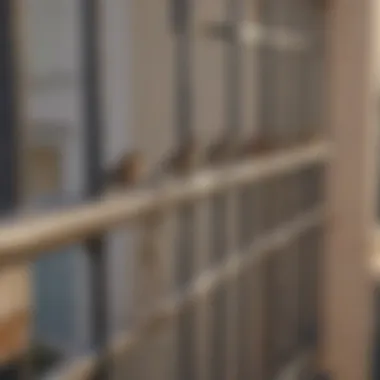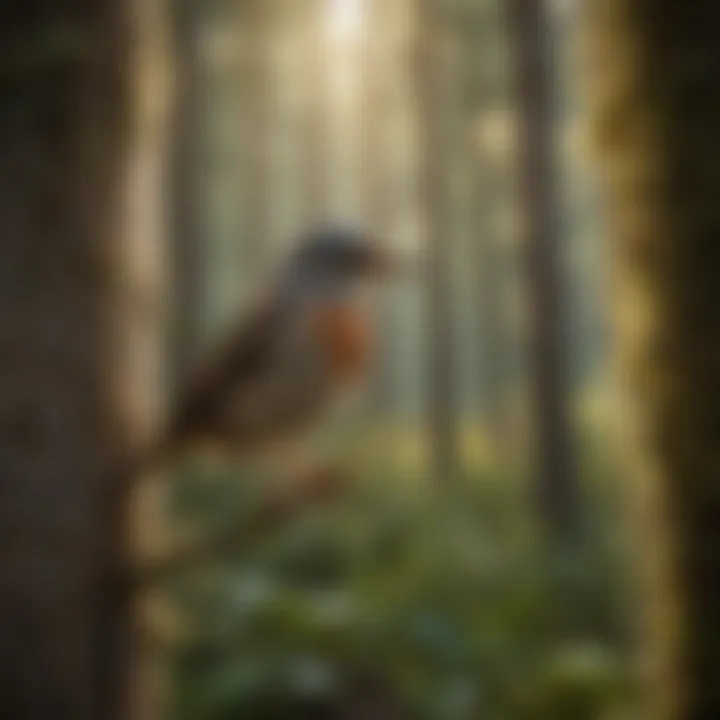Bird Deterrent Solutions: The Role of Tape


Intro
Managing birds in residential spaces can feel like an uphill battle. Not only can they be noisy, but they can also tend to make a mess out of well-kept patios or gardens. As a result, homeowners find themselves searching for practical solutions. One surprisingly effective method is the use of tape. It may seem simple, but tape can play a pivotal role in keeping unwanted feathered visitors at bay. This article dives into how tape acts as a deterrent against various birds, shares insights on the puzzle of bird behavior, and lays out methods that anyone can implement.
Understanding the Pest
Birds, depending on where you live, can be a mixed bag of picturesque creatures or persistent nuisances. Getting to know these avian visitors is crucial for effective deterrence. Their behaviors, preferences, and nesting tendencies often dictate how best to manage their presence.
Identification
Identifying the specific types of birds causing trouble is the first step. Common culprits include:
- Pigeons: They often seek shelter on awnings and rooftops.
- Sparrows: These small birds are notorious for flocking around food sources and shelters.
- Starlings: Known for their noisy gatherings, starlings often invade homes in search of nesting spaces.
Getting familiar with these species will allow you to tailor your approach effectively.
Life Cycle
Understanding the life cycle of birds provides deeper insight into when they might invade your space:
- Nesting: Birds typically nest in the spring, making your patio an attractive spot.
- Feeding: Depending on the species, they may look for food in your garden or near trash bins.
- Juvenile phase: Young birds often venture out, increasing your chances of encountering them.
Recognizing these phases can help in adjusting your deterrent strategies at appropriate times.
Pest Prevention Strategies
To reduce bird presence proactively, a combination of environment modification and physical barriers should be considered.
Environment Modification
- Eliminate Food Sources: Ensure outdoor dining areas are cleaned up promptly. Birds are opportunistic feeders, drawn to scraps.
- Water Sources: Removing free-standing water can deter birds looking to hydrate.
Physical Barriers
Here, tape comes into play effectively. Taping reflective materials or creating barriers using tape can dissuade birds from settling in. Key options include:
- Reflective Tape: Acts as a visual disturbance to birds, often confusing them.
- Sticky Tapes: These can be used in spots where birds frequently roost, making it less inviting.
"Physical deterrents can create an unwelcoming environment for birds without harming them."
Control Methods
While tape is an effective tool, it’s worth discussing broader control methods if the need arises.
Chemical Control
Using chemicals to deter birds is generally discouraged, as they can harm not only birds but also pets and desired wildlife. It's essential to consider less harmful methods first.
Biological Control
Introducing natural predators or using sound devices that imitate predator calls can also help, though not everyone appreciates the noise. Tape remains a sound choice because it's not just simplistic but also effective.
Epilogue
Understanding bird behavior and utilizing methods like tape for deterrence can significantly improve your outdoor space. By combining physical barriers with thoughtful modification of the environment, homeowners can cultivate a bird-free area without resorting to chemicals or other more intrusive methods.
Prologue to Bird Deterrence Methods
Managing bird populations in residential or commercial spaces is essential for a variety of reasons. Birds can cause a multitude of nuisances, ranging from minor annoyances like noise to significant issues including property damage and health concerns. It’s important to understand that while birds play vital roles in ecosystems—pollinating plants and controlling insect populations—they can also disrupt our lives when they invade our spaces. This balancing act is at the heart of bird deterrence methods.
Selecting a method to keep birds at bay is not simply about repelling them, but rather about using strategies that respect the birds while also effectively maintaining a bird-free environment. For instance, tape as a deterrent may seem unconventional, yet it offers several advantages.
Key Factors to Consider:
- Effectiveness: Different strategies vary in their effectiveness; understanding what works best can make a world of difference.
- Safety: Many deterrents on the market may utilize harmful chemicals or traps, and the inclination towards eco-friendliness is more prominent today.
- Cost Efficiency: Budget constraints often influence the choice of deterrent; tape is often an inexpensive solution that proves to be effective.
- Ease of Use: Some methods require specialized skills or tools, while tape can be straightforward and user-friendly for almost everyone.
Bird deterrence is a multifaceted approach that not only maintains our personal spaces but also encourages coexistence with nature.
Understanding the Impact of Birds


Birds, while beautiful and integral to many ecosystems, can often become more of a headache than a marvel in populated areas. Their droppings can corrode surfaces and structures, while nests may block drainage or plumbing systems, leading to unwanted repairs and upkeep. Moreover, certain species are known to pose a risk in agricultural settings, damaging crops and leading to economic losses.
"An ounce of prevention is worth a pound of cure."
Through preventive measures, such as using tape, homeowners can minimize risks in an efficient manner before issues escalate.
Overview of Common Deterrent Techniques
A wide range of deterrent techniques is available, each with its unique strengths and weaknesses. Choosing the right one often depends on the specific setting and the type of birds involved. Here’s a quick rundown:
- Visual Deterrents: Items like reflective tape, shiny objects, or scare balloons can confuse and scare off birds due to their unfamiliar appearances.
- Sound Devices: Devices or tapes producing sounds that mimic predators can effectively discourage birds from lingering in a given area.
- Netting and Barriers: Physical barriers can create boundaries that prevent birds from accessing particular zones, though they may require a bit more effort to install.
- Taste Aversion: Some products make food sources unpalatable to birds, thus deterring them from foraging in specific areas.
Tape, particularly in its various forms, fits squarely in the visual deterrent category. Each technique brings something different to the table, and it is crucial to evaluate them in the context of the intended environment and the bird species concerned.
The Science Behind Bird Behavior
Understanding the science behind bird behavior is essential for anyone looking to deter these creatures effectively. Bird behavior is influenced by various factors, ranging from their natural instincts to environmental stimuli. By diving deep into these aspects, we can tailor our deterrence strategies, such as using tape to keep birds at bay. It's not just about what we apply; it’s about grasping why birds are attracted to certain areas and how we can disrupt that attraction.
Natural Instincts and Habitats
Birds have evolved over thousands of years to be sensitive to their environment. Their instincts guide them in choosing habitats that provide food, safety, and nesting opportunities. For instance, urban areas filled with trees and shrubbery can appear attractive to birds, as they mimic natural habitats. House owners must understand that birds instinctively seek out such sanctuaries for their survival. For example, a simple garden with vibrant flowers can be a beacon for local bird populations. Therefore, knowing the natural habits of birds can help in deciding where to implement deterrents like tape.
One instinctive behavior frequently observed is their affinity for open spaces with strategic perches. Birds often look for vantage points where they can scope out threats as well as potential food sources. When tape—especially reflective kinds—are used, they disrupt these natural perches and thus deter birds from settling down in those areas.
Triggers for Bird Attraction
Aside from instincts, certain triggers entice birds closer to human environments. These can include:
- Food Sources: Gardens or trash areas, which can unknowingly provide sustenance.
- Nesting Materials: Shredded items left around can become tempting for nest-building.
- Water Availability: Pools or bird baths act as attractions.
An insightful approach to minimizing bird attraction involves recognizing these triggers. For instance, birds can be drawn to shiny objects; thus, reflective tape can not only serve as a deterrent but also reduce the perceived value of your property as a food or nesting ground.
"Bird behavior is primarily dictated by instinctual responses to environmental factors—by understanding these factors, we can effectively manage bird populations."
When utilizing tape in bird control, recognizing the attraction triggers becomes invaluable. Adjusting your environment and employing tape in strategic locations can significantly deter these feathered visitors. This comprehension is not merely about applying a method; it is about understanding the underlying motivations of the birds, which in turn informs your strategy comprehensively.
Tape as a Bird Deterrent: An Overview
Understanding the use of tape for bird deterrence is crucial in the broader conversation about managing bird presence effectively. Birds can be delightful additions to our gardens and surroundings; however, they can also create challenges for homeowners, especially when they start to occupy spaces we want to maintain pristine. This chapter dives into how tape serves as a non-invasive method, emphasizing its accessibility and effectiveness. The advantages of utilizing tape include affordability, ease of installation, and minimal environmental impact compared to some traditional methods.
Types of Tape Used for Deterrence
Reflective Tape
Reflective tape has gained traction as a popular choice for deterring birds. Its key characteristic is the shiny surface that reflects sunlight, which can be quite disorienting to birds. This disorientation can lead to them avoiding areas where this tape is in place. The unique feature of reflective tape is its versatility; it can be applied in various outdoor settings, like gardens or rooftops.
One advantage of reflective tape is its low cost and ease of use, meaning you won’t break the bank to give it a try. Plus, unlike some other deterrents, it doesn’t require any professional installation. However, it should be noted that its effectiveness may diminish over time, especially in weathered areas, so some maintenance might be necessary.
Acoustic Tape
Acoustic tape is another intriguing option that logicaily takes advantage of sound as a deterrent. This tape generates noise when wind passes through it, creating a form of auditory deterrent that can keep birds at bay. The key characteristic of acoustic tape lies in its ability to disrupt the otherwise tranquil environment, often unsettling birds that rely on sound for navigation and communication.
The unique feature of this tape is its ability to blend well with the surroundings. Acoustic tape comes in various colors that can discreetly fit into your outdoor decor. A downside, though, is that it might not be as effective in calmer environments where sound does not travel as easily. The reliance on environmental factors makes its performance somewhat inconsistent.
Adhesive Tape
Adhesive tape serves a more straightforward purpose: acting as a physical barrier. The central aspect of adhesive tape lies in its stickiness, which can prevent birds from perching or nesting in specific areas. This method is particularly beneficial for spots that experience constant disturbances from unwanted bird activity. One of the significant advantages of adhesive tape is that it provides a more lasting solution; it stays in place as long as its adhesive properties hold.
Nonetheless, the downside shouldn't be ignored. Over time, the adhesive may degrade due to weather conditions, making it less effective. Additionally, while this tape may offer a deterrent, it can also leave behind residue after removal, which is something to consider if you value aesthetics.
Mechanisms of Action
Visual Deterrents
Visual deterrents play an essential role in how tape functions to keep birds away. The key characteristic of visual deterrents like tape is their ability to capture the attention of birds through sight, often reflecting light and creating patterns that can confuse or scare them away. The unique feature of visual deterrents is how it incorporates shiny or reflective elements that disrupt a bird's line of sight.
This method proves to be beneficial because it’s a non-lethal way of managing bird movement. Birds are naturally programmed to avoid potential threats, and bright signals can sometimes send them packing elsewhere. However, while effective initially, over time, birds might acclimate, which can reduce the tape's effectiveness unless repositioned frequently.
Auditory Deterrents
As previously highlighted through acoustic tape, auditory deterrents can significantly impact bird behavior. This method utilizes noise to make particular areas feel less appealing. The key characteristic here is that various sounds can mimic predators or create irritation for the birds.


It's particularly effective when combined with other methods, providing a one-two punch that can enhance overall deterrent effectiveness. Like visual deterrents, it can offer a humane solution to bird management, which is increasingly valued by many homeowners. However, the challenge with auditory methods is that sound can be unpredictable; a lack of wind or nearby disturbance can render them ineffective, suggesting they’re best used as part of a multifaceted approach.
Proper implementation of these methods ensures a balanced approach to bird management while promoting the local ecosystem's health.
Implementing Tape for Bird Control
Implementing tape as a method for controlling bird presence holds significance in diverse settings. This technique is not only practical but also offers several benefits. Birds, often seen as charming creatures, can become nuisances when they disrupt gardens, crop yields, or urban tranquility. For instance, the presence of flocks can lead to damage, mess, and even health risks due to droppings. Thus, employing tape in strategic locations serves both decorative and protective roles. Not only is it eco-friendly compared to traditional deterrents, but it is also relatively simple to use and cost-effective. By understanding the suitable areas for application and the correct installation techniques, homeowners can reap the rewards while minimizing the fuss.
Strategic Areas for Application
Gardens and Patios
Gardens and patios provide an ideal setting for utilizing tape due to their open nature and prevalent bird activity. These spaces often attract birds looking for food or nesting spots, which can become quite the headache for gardeners. The key characteristic of gardens and patios is their appeal to various bird species. Therefore, using tape here can be a beneficial choice. Tape can be draped over plants or hung near tempting areas, creating an unpleasant environment for birds. An essential feature of such applications is how they can blend seamlessly with the aesthetics of the space while effectively deterring unwanted avian guests. However, one must consider that depending on the tape's material and placement, it may detract from the garden's natural beauty.
Agricultural Areas
Agricultural areas represent another critical zone for implementing tape as a deterrent. These regions are often targets for birds looking for a feast among grains, fruits, and vegetables. The notable aspect of agricultural areas is the intricate balance between attracting helpful pollinators and deterring opportunistic pests. Thus, tape serves as a popular method to safeguard crops without resorting to harmful chemicals. Its unique ability to reflect light or produce sound can create an environment unsuitable for birds. Nonetheless, farmers should ensure that the tape is installed correctly to maintain efficiency, as poor placement can diminish its effectiveness.
Urban Settings
Urban settings present their own unique challenges in bird management. Parks, plazas, and balconies often attract various bird species in search of food or nesting habitat. In these situations, the key characteristic of urban settings is their dense human population, which demands non-invasive solutions. Implementing tape in these areas serves as a useful deterrent without disturbing the peace. Reflective and colorful tapes are especially advantageous, as they captivate the attention of birds while not being overly disruptive to humans. However, it is important for urban residents to keep an eye on how effective the tape is, as its functionality might be reduced over time due to pollution or weather conditions.
Installation Techniques
Height and Angle Considerations
When installing tape for bird control, height and angle considerations are paramount. The successful implementation of tape often hinges upon its positioning in relation to bird flight paths. A higher installation can prevent birds from easily accessing certain areas while angles can enhance the visibility of the tape, maximizing its deterrent effect. An advantageous feature of this approach is its versatility; adjustments can easily be made based on observable bird behavior. However, if installed too high or at the wrong angle, it might become ineffective as birds can find alternative routes.
Maintaining Adhesive Properties
Keeping the adhesive properties of the tape intact is essential for long-lasting bird control. Environmental factors such as moisture, dust, and temperature fluctuations can impact how well the tape sticks to surfaces. Regular checks to ensure that the tape remains fully adhered can prolong its lifespan and effectiveness. The distinct characteristic of maintaining adhesive properties lies in its simplicity—cleaning surfaces before installation and avoiding heavy weather conditions during application can make a world of difference. One downside, however, might be the need for periodic replacement if the tape loses its grip, making it vital to factor in upkeep when choosing this deterrent method.
Effectiveness of Tape in Bird Management
Using tape as a means of bird deterrence is gaining traction among householders and garden enthusiasts alike. It serves as a straightforward, no-nonsense, and cost-effective approach, particularly in residential areas where bird presence can wreak havoc on gardens and outdoor spaces. Effectiveness comes down to the combination of visibility, sound, and the overall method of application. In this section, we explore the specific elements that underline how tape can be an integral part of managing bird populations while considering its benefits and practical applications.
Tape can play a versatile role in bird management strategies, essentially acting as both a visual deterrent and a barrier to entry. The effectiveness typically hinges on several key factors. First, there’s the nature of the tape—its color, reflectiveness, and whether it produces sound. These attributes can influence the birds' reactions significantly. For example, reflective tape can disorient foraging birds not just because of the glare, but also due to fast-moving visuals that catch their attention. Other types like acoustic tape can create sounds that mimic natural threats, adding another layer of behavioral modification for the avian visitors.
Another important consideration is the installation of the tape. Proper placement is essential for maximizing its deterrent capabilities. Areas prone to bird activity, such as window sills, balconies, or feeding zones, should be prioritized. Additionally, frequent maintenance ensures that the tape's effectiveness is sustained over the seasons. A forgotten, peeling sticky mess might do little more than attract unwanted guests—few birds can resist a good meal!
Benefits of Using Tape:
- Eco-Friendly: Tape poses minimal harm to the environment compared to chemical deterrents.
- Cost-Effective: Typically inexpensive, it can be a financially savvy choice for homeowners.
- Versatile: Can be used indoors and outdoors, across various settings and environments.
- Simple Installation: Most tapes require no special tools, and application is straightforward.
In summary, the effectiveness of tape as a bird deterrent lies in its multifaceted nature. With thoughtful selection and application, it can be an essential tool in maintaining a bird-free zone.
Case Studies and Real-World Applications
Let’s delve into some real-world scenarios where tape has played a pivotal role in managing unwanted birds. Case studies provide tangible evidence of effectiveness and reveal the nuances of implementation on various premises.
One compelling example comes from urban homeowners who have battled persistent pigeon nuisances. In this context, property owner Helen used a mix of reflective and adhesive tapes around her balcony. Initially dubious about the effectiveness of tape, she was pleasantly surprised to witness a significant decline in the feathery intruders. The combination of shiny surfaces and sticky barriers made her balcony much less inviting for the pigeons.
Another telling case is found within agricultural settings. A farmer dealing with sparrows that raided crops turned to acoustic tape as a part of his integrated pest management approach. By hanging strips of acoustic tape in strategic locations, the farmer repelled birds while also fostering a harmonious coexistence with the environment, focusing on organic farming practices rather than pesticides. Evaluating growth yield pre- and post-application pointed to a noticeable increase, which he attributed directly to the deterrent efficacy of tape combined with other natural methods.
"In practice, simple steps often yield significant results."
These case studies highlight the practical realities and outcomes that homeowners and farm operators face, showing that tape can work effectively, provided it aligns with broader pest management strategies.
Comparative Analysis with Other Methods
When evaluating the effectiveness of tape, it is crucial to compare it against other bird control methods. Not all deterrent options yield the same results, and understanding their strengths and weaknesses assists property owners in making informed decisions.
Advantages of Tape Over Other Methods
- Cost: Tape is typically less expensive than installing physical barriers like nets.
- Simplicity: Unlike traps or some electronic deterrents, tape does not require extensive monitoring or expertise.
- Non-Invasive: Many methods rely on complex systems or chemicals, while tape remains uncomplicated and harmless.
Limitations Compared to Other Techniques
- Durability: Tapes may need replacement more frequently than other methods; they can succumb to wear and weather conditions faster.
- Limited Reach: While tape works well in targeted areas, it may need to be combined with other methods for larger infestations.


Finale of Comparative Analysis
Tape shines as a useful tool in the arsenal against birds but is often most effective when integrated into broader strategies. Understanding its niche applications and benefits compared to traditional bird deterrents allows homeowners to tailor their approach, thereby enhancing overall pest management efficacy. By opting for material that fits their specific environment and needs, they can craft a comprehensive solution to keep their spaces bird-free.
Eco-Friendly Alternatives to Tape
As the spotlight shifts towards sustainable practices, the discourse around eco-friendly solutions for bird deterrence has gained significant traction. It’s paramount for homeowners and pest control professionals to consider alternatives that avoid environmental harm, while still tackling the challenges posed by feathered visitors. The importance of eco-friendly methods lies not just in their effectiveness, but also in fostering a harmonious relationship between humans and wildlife. These alternatives can complement tape use, offering a multi-faceted approach that doesn’t solely lean on adhesive methods.
Natural Repellents
Natural repellents present an intriguing opportunity to deter birds without disrupting their environment. Many substances found in your kitchen or garden can prove useful in warding off these avian guests. For instance, cayenne pepper or essential oils, such as eucalyptus or peppermint, can be sprinkled or sprayed in areas where birds tend to congregate. These substances, generally safe for the environment, create an unpleasant experience for the birds—think of it as a no-fly zone that doesn’t rely on sticky traps or harsh chemicals.
Natural repellents are often favored not just for their effectiveness but also for their accessibility. Homeowners might find themselves pleasantly surprised at how easy it is to craft these solutions. Here’s a list of common natural repellents:
- Cayenne pepper
- Eucalyptus oil
- Peppermint oil
- Garlic powder
- Vinegar
The application can be as simple as mixing these ingredients with water and spraying them directly in problem areas. However, it’s wise to reapply these solutions regularly, especially after rainfall; nature has a way of washing away our best intentions!
"Eco-friendly methods show us that we don't need to wage war on wildlife; rather, we can find ways to coexist with them."
Habitat Modifications
Another effective avenue for managing pesky birds involves making strategic modifications to the habitats in which they thrive. By understanding their preferences and behaviors, homeowners can take steps to make their spaces less inviting. Birds often look for places that provide shelter, nesting opportunities, and food sources. If we can alter those elements, we can reduce the likelihood of birds settling in.
Key habitat modifications include:
- Removing standing water: Birds are drawn to water sources for drinking and bathing. By eliminating standing water around your property, you can decrease attraction.
- Trimming trees and shrubs: Overgrown foliage can provide perfect nesting spots. Keeping trees and shrubs neatly trimmed can discourage birds from calling your home theirs.
- Sealing entry points: For species prone to nesting in eaves or attics, applying proper sealing methods can safeguard these areas.
- Managing food sources: Ensure that bird feeders are removed or covered when not in use. Also, clean up fallen fruit or seeds promptly as they might attract unwanted guests.
The beauty of habitat modifications lies in their synergistic effect. When combined with tape solutions, these adjustments can create a comprehensive strategy that not only deters birds but also promotes a more sustainable living environment that respects the balance of nature.
Harnessing these methods allows for a proactive approach, minimizing the reliance on tape alone while preserving the ecological features of your surroundings.
Broader Context of Pest Management
When we consider the challenges of maintaining a bird-free environment, it's essential to place tape use within the wider ambit of pest management. Pest management isn’t just about eradication; it embraces prevention, control, and sustainable practices. It's about orchestrating a harmonious coexistence with nature while safeguarding our spaces from unwanted visitors.
Tape serves as one of many tools in a broader pest management strategy. Understanding its role highlights the advantages it brings to various settings, whether we’re dealing with urban birds or those feasting in agricultural areas. This approach helps ensure we don’t incurr costly damages to crops or other property.
Integrating Tape within a Pest Control Strategy
Integrating tape into a comprehensive pest control strategy requires a keen understanding of various factors. First and foremost, know your goals. Are you simply trying to keep specific birds away from your garden? Or are you protecting a larger agricultural investment? By setting clear objectives, you can utilize tape effectively as part of a broader methodology that may include other deterrent methods such as natural repellents or habitat modifications.
- Assessment of Areas: Identify where birds are problematic. Tape works well in areas like fruit trees or near grain storage.
- Choosing the Right Tape: Not all tape fulfills the same function. Reflective tape offers visual deterrence, while acoustic tape adds an auditory aspect. Choose based on your specific need.
- Regular Monitoring: Tape may need periodic checks, making sure its effectiveness hasn’t diminished due to weather conditions or wear and tear. Keeping a close eye lets you adapt the strategy as needed.
Overall, tapping into tape as part of your pest control strategy means being proactive rather than reactive which can lead to more lasting solutions.
Long-Term Solutions for Pest Management
Long-term pest management strategies stand on the foundation of careful planning and adaptability. These are not one-size-fits-all solutions, as they account for changing circumstances and advances in pest control technology. To solidify the role of tape in longer-lasting strategies, consider these elements:
- Combining Techniques: Utilize tape in tandem with other methods such as netting and natural repellents. This multi-faceted assault brings stronger resilience against return invaders.
- Regular Maintenance: Keep your tape installations in check. A peeling edge on your tape can signal lost effectiveness, allowing for gaps in your defenses.
- Community Awareness: Engaging with neighbors can amplify pest control efforts. Sharing knowledge about successful tape usage increases the chance of collective success.
Having a long-term perspective ensures that tape is not just a quick fix but part of a sustained effort toward a bird-free environment. It urges you to think long-term about your gardening practices, urban planning, or farming, all while focusing on a balanced interaction with wildlife.
Ending and Future Directions
As we reach the end of this comprehensive exploration into utilizing tape as a bird deterrent, it becomes clear that this method can serve as a practical tool in maintaining a bird-free environment. The nuances of bird behavior, along with the variety of tape types available, highlight the importance of a strategic approach in pest management. Not only does tape offer a non-toxic solution, but its accessibility makes it a viable option for homeowners ranging from suburban houses to urban balconies.
The discussion surrounding tape as a deterrent also points to the broader implications of effective pest management strategies that prioritize ecological balance. By leveraging tapes like reflective varieties or acoustic options, one can manage avian visits effectively without resorting to harmful substances that could affect other wildlife or environmental health. Thus, recognizing the effectiveness of tape and combining it with other methods can lead to a more comprehensive treatment plan.
"Innovative approaches in pest control require a balance of efficacy and sustainability, ensuring a proactive stance towards both homeowner concerns and ecological responsibility."
Summarizing Key Insights
The blend of information presented gives a clear roadmap of how tape can play a pivotal role in bird deterrence:
- Types of Tape: Each kind - reflective, acoustic, and adhesive - brings unique advantages tailored to specific scenarios, allowing flexibility in application.
- Behavioral Understanding: Knowledge of birds’ attraction triggers can maximize tape effectiveness, ensuring installations resonate with avian instincts.
- Installation Strategies: By choosing optimal locations and methods for installation, one can significantly enhance results, adapting the strategies to various contexts, including gardens, urban settings, and farms.
- Comparative Analysis: Insights drawn from real-world applications reveal that tape stands strong against traditional methods, often providing a cheaper, sustainable alternative.
While the details explored are grounded in practicality, they also illustrate the importance of birds as part of the ecosystem. Therefore, any measures taken should be carefully considered, balancing human needs with environmental sustainability.
Potential for Further Research
The possibilities for future inquiry into tape as a bird deterrent are both vast and intriguing. Here are some potential avenues worth exploring:
- Longitudinal Studies: Implementing extended studies to track the effectiveness of various tape types over different seasons and environments can yield valuable data, helping refine techniques based on long-term observations.
- Comparative Effectiveness: Research assessing the impact of tape combined with other deterrent methods could provide insights into synergistic effects that might enhance bird management efforts further.
- Behavioral Studies: Understanding specific bird species’ reactions to different tapes can guide targeted strategies for diverse settings, establishing a more nuanced approach tailored to local fauna.
- Community Feedback: Engaging with users through platforms like forums or social media can help gather a wealth of anecdotal evidence that aids in knowledge dissemination and technique improvement.
Conclusively, the insights gathered from this examination not only underscore tape’s role in deterring birds but also beckon a call to action for further studies and keen utilization, ensuring that pest control practices evolve alongside environmental considerations.







